A few weeks ago my son turned thirteen. I wanted to write something to celebrate this important milestone for him and for myself, but was not sure what to write about. One day I was flipping through some of the trip pictures we have taken over the years, and I came up with this idea: how about a blog on our travel experiences–all the places we have been to and all the memories we have created!
People who know us know we love to travel, and we love to travel as a family. We have been fortunate enough over the years to see, to visit, and to explore many places around the globe, stuffing our eyes with wonder. And travel is almost second nature to my son, since the days he was a small baby.
I could think of many ways how travel has enhanced my son’s learning experiences–his love for adventure, his interests in geography, world maps and airplanes, his appreciation for multilingualism, his empathy for others, his curiosity for how things work, and his ease in adapting to changing situations. But most of all, travel has strengthened us as a family. We each find a happiness anchor through travel–in the fun and joy of experiencing and figuring out a whole new place together. We relax, rewind, and recharge. These experiences will become some of the most cherished memories for us to remember many years down the road.
So rather than diving into the thickness of raising an ever-independent teenage boy, I’d like to pause for a few moments and savor some of the sweetest and most unforgettable memories we have created together–through the many family trips we have taken over the years.
2005: An Italian Renaissance Baby
Our family adventure began in 2005. Barely 7 months old and snugged in a Baby-Bjorn, my son ventured out with us on our very first family trip to Italy. Immediately he became a great travel companion. Happy and content, he napped wherever he could and whenever he wanted–in a bassinet by the bulkhead seat on the airplane, in the open air under the Tuscany sun, and in a Baby Bjorn with which we carried him around. I nursed him along the way, often at the most unforgettable places–on top of the magnificent Duomo, inside the amazing Uffizi Gallery, in front of Michelangelo’s masterpiece, David, and on the one-of-a-kind Gondola…
When he was awake, he giggled and bounced with endless energy while we strolled leisurely admiring the Italian beauties: the Arno River, Ponte Vecchio, Piazzale Michelangelo, Boboli Gardens, Piazza San Marco, the Grand Canal, the Campanile, Rialto Bridge, the Querini Stampalia Foundation by Italian architect Carlos Scarpa and many many more. The success of our first overseas family trip inspired us to continue to travel to many other places over the years. With each trip we took, we became more relaxed, more spontaneous, and more adventurous. So we came up with a tradition: for each country we visited, we would buy a small flag for my son to keep. Now 13 years later and 24 countries down the road, he has a small collection of country flags, each bringing back many wonderful memories. I chuckle every time I look at the many old and new airline tags on his carry-on luggage. 2006: A Little Explorer in Prague and ViennaOur second family adventure took us to Prague and Vienna. He was 1 1/2 years old. Like a little explorer, he ran, he hopped, and he giggled. We cut back on our museum visits and followed his cues: chasing pigeons, picking flowers, surveying the streets, flipping through the guidebook, playing hide and seek, and even sipping from a giant empty beer stein.
His playground included these fabulous sites: Charles Bridge, Old Town Square, Prague Castle, Schönbrunn Palace, St. Vitus Cathedral, Vienna State Opera House, Church of the Most Sacred Heart of Our Lord by Slovene architect Jože Plečnik, and Austrian Postal Savings Bank by Austrian architect Otto Wagner…One could not have asked for better places to have fun! 2007: Oh, Lego–These Wonderful Color BlocksIn 2007 we traveled to three countries in the Caribbean and Europe: the Bahamas, the Netherlands and Denmark.
Sometimes the best trips are the ones that have no agenda. That was our trip to the Bahamas. In a family re-union to celebrate my in-laws’ 50th anniversary, we stayed in a beachfront cottage. No car-horn noises, only the ocean sounds and laughing seagulls. We roamed freely along the beaches, picking up seashells, building sand castles, swinging in hammocks, splashing in lukewarm ocean water, and watching sunrise and sunset from our cottage…Nature could not be more beautiful and peaceful than what we had.
As an architect and a world traveler, my husband’s deep and extensive knowledge in art, history and architecture has been truly an asset in shaping my son’s (and mine for that matter) travel experiences. We often visited the most unusual places a typical tourist would not have known or considered. And with a live encyclopedia by our side. In Netherlands and Denmark, we visited the major tourist sites, having so much fun watching the windmills in Amsterdam, admiring the Little Mermaid and playing at Tivoli Gardens in Copenhagen. But we also visited a few Dutch architects-designed buildings–the Kunsthal in Rotterdam by Rem Koolhaas, the Schröder House in Utrecht by Gerrit Rietveld, the Hilversum Town Hall in Hilversum by Willem Dudok, and the Bagsværd Lutheran Church by Danish architect Jørn Utzon. At the time my son was too young to appreciate the exquisite beauty of these architectural landmarks, but over the years his ability to name buildings and identify design styles, and his love for geography have expanded exponentially.But the highlight of this trip was his discovery of Lego, these simple and elegant bright-colored Danish plastic blocks. He was completely enamored of them and had his first Lego acquisition in Copenhagen–a 4-piece Duplo tractor. I still remember vividly that huge grin on his face when he finished building the Lego tractor. Since then his love for Lego has taken off and he has become a huge Lego fan. Nowadays he often designs his own Lego structures and can build sophisticated sets very fast. Here is a picture of him holding his Saturn V Rocket–a 2000-piece Lego set he finished building within an hour on his 13th birthday.
2008: Rome, Paris and London through the Eyes of a ToddlerRome is a heaven for adults and children alike. If piazzas are microcosms of Roman life, these marvelous open spaces are natural playgrounds for young children too. This year we had the best time touring around Rome, not through museum hopping, but by running around with our 3-year-old boy. He had left trails of belly laughs on the Spanish Steps of Piazza di Spagna, by the fountain of the stunning Piazza Navona, in the open space of the grandeur Piazza del Popolo, and around the sculpture of the charming Piazza Mattei...
In Vatican City he “wrote” his very first postcard and mailed it to himself back home. He looked so tiny inside the magnificent Colosseum. He followed an old tradition and threw not one but two coins into the Trevi Fountain, eager to come back again. He played hide and seek for hours end in the garden mazes of Villa d’Este, and he made friends with gold-fish and turtles in a pond at Villa Giulia. Our introduction of Paris and London to him took place this year. Two of my favorite places in the world, Paris and London have special meanings to us too. Paris is where my husband and I went on our honeymoon in 2003, and London has a landmark that bears my son’s name. Needless to say we had a grand time sightseeing and entertaining in these two great cities. We climbed up the Eiffel Tower, walked under the Arc de Triomphe, strolled along Avenue des Champs-Élysées, and attended a beautiful service in Notre Dame. But what my son enjoyed the most was running around in the courtyard of Musee du Louvre, playing with sailboats in a Tuileries Garden fountain, chasing pigeons in front of Notre Dame and admiring the bold colored sculptures at Pompidou Center designed by Renzo Piano and Richard Rogers. In London we walked on the Tower Bridge, took pictures under the Big Ben, rode on the London Eye, and watched the change of guards in front of Buckingham Palace. He was thrilled to see Paddington Station in person, one of his beloved train stations from his story books. Looking at the radiant smiles on his face, I know my son, influenced by his mom and dad, has found his happiness anchors in globe-trotting at a very young age.2009: Three American Vikings in Two Nordic Countries
In 2009, we visited two Scandinavian countries: Sweden and Norway. We took a slow-paced trip to enjoy Stockholm, Oslo and Bergen. Stockholm had a lot to offer in its orderly and quiet manner: we walked through Swedish history in the Skansen Open-Air Museum, Drottningholm Palace and Storkyrkan–Stockholm Cathedral. In Oslo, we strolled inside the Vigeland Sculpture Park enjoying the many displays of Gustav Vigeland’s works. We took a cruise trip along Oslofjord, completely in awe with the beautiful Norwegian coastline.
For my son, however, this trip was all about ships, boats, vessels, and sea maps. In Stockholm Vasa Museum had a lasting impression on him. It largely told the story about how the Vasa ship capsized and sank in Stockholm in the 17th century, and after 300+ years on the sea bed how the mighty warship was salvaged. I remembered watching him listen attentively to his dad tell the story, and gaze at the giant ship quietly, absorbing all in. A few years later, when he heard the story of Titanic for the first time, he immediately asked about Vasa, a connection that he had naturally drawn from this trip.In Oslo’s Kon-Tiki Museum he climbed up the original vessel, Kon-Tiki, that took Norwegian adventurer Thor Heyerdahl on his expedition from Peru to Polynesia. At Viking Ship Museum, he was fascinated with the various ships in the Viking Age, including the beautiful Oseberg ship.
In Bergen, he played with a giant anchor on the street for hours end, and took the Fløibanen funicular ride many times to Fløyen, 300 meters above the sea level, enjoying fantastic views of Bergen.Over the years, I have watched in amazement how these experiences have slowly shaped his various interests and skills growing up. For example, his understanding of world geography has come naturally and effortlessly, it seems to me. His transportation vocabulary has expanded by leaps and bounds to include the Metro in Paris and the Underground/Tube in London, the Metropolitana in Rome, the Tunnelbana in Stockholm, the T-bane in Oslo, and Mass Transit Railway in Hong Kong, all of which have remained his favorite subway systems till this day. His knowledge about airplanes is also very impressive: every time he finds an airplane in the sky, he can tell exactly what airline is and what type of the aircraft is, to the smallest details…
2010: Spain is Beautiful, and So is Our Bunny’s Story
In the following year, rather than visiting two countries on one trip, we decided to visit a few cities of the same country. Spain was on our mind and Barcelona, Seville and Granada were on our top list.
Arguably the most influential Catalan architect, Antoni Gaudí has left a trail of his masterpieces in Barcelona, both highly individualized and distinctive in style. We had a grand time touring around in Casa Milà, Park Güell, Casa Batlló, and Güell Pavilions. It was inside the still-incomplete Sagrada Família where my son told us he would take us back again in 30 years when Sagrada Família would be finally finished. And he remembers his promise till this day.
This trip also took us to three unforgettable places–the Alcázar of Seville, the Alhambra of Granada, and Barcelona Pavilion in Barcelona.My husband has had a strong fascination with the Alcázar ever since he visited this royal palace with his family as a young boy. I, on the other hand, had never heard of it until this trip. Visually stunning and architecturally mesmerizing, the Alcázar was truly one of the most magnificent places I have ever visited, and it opened my eyes for the beauty of Moorish Culture. While my husband was busy enjoying Alcázar’s spectacular architecture, my son and I roamed around inside the palace, from courtyard to gardens. Everywhere we went, we would run into a kaleidoscope of stunning colors, gorgeous mosaics, and beautiful interiors… Simply an amazing experience.
Equally incredible was our visit to the Alhambra, an imposing castle on a picturesque rocky hill in Granada. With plain walls of the fortress exterior, the Alhambra was originally designed as a military base, and eventually became the residence of royalty. Its interior spaces were exquisitely detailed and highly ornate, often connected by gardens, gates, and paths. Perhaps because of its breathtaking beauty, the great American writer Washington Irving spent a year inside the palace writing “Tales of Alhambra,” a series of essays and stories about Moors and Spaniards that were instrumental in re-introducing the Alhambra to the western audience.Enchanted by the exquisite gardens and paths, my son often hopped from one fountain to another, searching for the beginning and end of the water. It was quite entertaining for him.
But the highlight of this trip for him was his happy encounter with the baby bunnies along Las Ramblas, Barcelona’s famous promenade, where Barcelonés set up many stands each morning selling a variety of goods, including small pets. There we found a rabbit stand with a few cages that housed white, grey and black colored baby bunnies. My son was so enamored with these tiny soft furry friends, he kept going back to these cages. That joyful experience inspired him to adopt his very own pet bunny upon getting home. Ollie, a name he gave to his bunny, has since become part of our family. I cannot leave this section without talking about our visit to Ludwig Mies van der Rohe‘s Barcelona Pavilion. Originally designed as the German Pavilion for the 1929 International Exposition in Barcelona, Barcelona Pavilion was minimalism at its best: its simple form, its infinite tranquility, its “floating” roof, its spectacular use of extravagant materials, such as marble and red onyx, and its iconic Barcelona Chair have inspired many important modernist buildings. To a layperson like me, Barcelona Pavilion has left a profound impact: it quiets my mind every time I think of it. 2011: Instilling a Touch of Fun-Loving Latin SpiritIn 2011, we flew to the southern hemisphere. A fun and low-key trip, we visited Argentina and Uruguay. In Buenos Aires, everywhere we went, we could feel the Latin vibe. On the streets and in the parks, at the crack of dawn or under the midday sun, children played soccer like pros, and men and women tangoed with passion and style. My son, wearing a No. 10 Argentina soccer team jersey, had a big kick taking pictures in front of a mural of Diego Maradona, a super soccer star in Argentina.
At the famous Independence Square of Montevideo, capital of Uruguay, he played tag with us, kicked soccer balls with local kids, and ran from one end of the square to the other, laughing and giggling.
Though food is not the topic of this blog, I must say we had the best mouth-watering steaks in Buenos Aires. Ever.2012: A Friendly Donkey and Never Enough Italy
To say we will never grow tired of Italy is not at all an exaggeration. In the summer of 2012, we went back to Florence and Venice. This time we rented a villa in Rufina, a quiet town in the rolling hills, about 15 miles northeast of Florence. Perched in the natural landscape and with a sweeping view of Tuscany, our villa was surrounded by flower-covered meadows, fruit orchards and olive groves. A stone staircase led up to four double bedrooms and a large country-style kitchen. All bedrooms had French doors to the garden with shade provided by cherry trees.
Down the hill from our villa was a small farm where a donkey lived in a shed. Every morning on our way to the local commuter train station, we would go past the donkey. We made a point to stop to greet him. As if anticipating our arrivals, the friendly donkey would walk slowly to the gate upon seeing our car. My son fed him with apples or hay every time we stopped by, an activity he enjoyed very much.
In the evenings we often came back to our villa to cook hearty meals with the freshest ingredients we could find in the exquisite local shops. For a week we lived a simple, quiet and un-hurried life, the Italian way.
We watched with the locals the UEFA Euro semi-final game where Italy beat Germany, experiencing first hand the Italians’ unmatched enthusiasm for soccer and their soccer super stars. It was quite enchanting.In Venice, we stayed in the same hotel as we had during our first trip, tracing our footsteps to discover changes in the places since the last time we had been to. Some shops were gone but Venice‘s charm stayed.
2013: A Camel Safari into the Sahara Desert: Once in a Lifetime Experience
The 2013 trip to Morocco was our first trip to Africa and a magnificent one, to say the least. From Marrakesh to Casablanca, from Rabat to Fez, from Merzouga to Ouarzazate, from the High Atlas Mountains to the Sahara Desert, the people we met, the food we ate, the places we visited, the things we did…I could devote an entire blog to this trip, but still feel there is not enough space to write about our incredible experiences.
If I were to choose one experience to write about, I would definitely choose our journey into the Sahara Desert. The afternoon we took a slow and soulful camel safari deep into the desert’s heart, the evening we ate the most delicious chicken Tagine around a mesmerizing campfire, the night we camped out on a soft bed of sand beneath the clearest stars on earth, and the morning we watched sun emerge slowly and naturally behind the seemingly eternal sand dune. Two African camels, one Moroccan guide and three American travelers, we had a truly once in a lifetime experience. I remembered sitting on a vast sea of orange sand and watching my husband and my son climb up and run down the perfectly wind-sculpted sand dune, laughing, shouting and giggling, tears started to well up in my eyes. The awesome expanse of nature seemed more humbling than some of man’s most grandiose structural creations, I thought. Right at that moment, I had achieved peace of mind, the closest I’d come to understanding of happiness. In a fount of solitude, I couldn’t think of a single thing I lacked. The magic of nature.The pictures are probably worth a thousand words. These are the colors of Morocco, bright, bold, exquisite and unbelievably beautiful. We will forever cherish this trip.
On the way back from Morocco, we stopped in London for a few days. This time we paid a special visit to the famous Abbey Road to please the hearts of two Beatles fans–a boy and a man. This year also marked the 10th anniversary for my husband and me. We decided to take our son to see Paris again, where we started off together as a globetrotting couple. We revisited the restaurants, cafes, churches and museums we had been to during our honeymoon. We showed him the tiny hotel room we had stayed in before, just big enough to keep a double bed and a small desk in. We told him how we thought French baguette and fromage–two food items we had eaten so much during our honeymoon–could be so unbelievably delicious and affordable. We wanted to show him that travel didn’t have to be luxurious in order to be fun.The only disappointment was we didn’t get a chance to take him to Poissy, a town on the outskirts of Paris, to see Le Corbusier’s masterpiece, Villa Savoye, the first and the best (besides Barcelona Pavilion) modernist building that I came to know. But there was always next time to be back to Paris.
2014: Enjoying a Quiet Life in Florence
Third time is a charm, and indeed, we went back to Florence for the third time in 2014. To the same villa. For a longer period. The friendly donkey had moved away, but Florence was still as charming as one could have possibly hoped for. Now my son was older, he was more receptive to a formal introduction to Italian Renaissance arts. And we did just like that. We hopped into many museums and galleries, big and small. We drove around here and there, and added Lucca and the Cinque Terra to our “have-been-to” list.
But most of the time, we stayed in our villa and enjoyed a quiet life. We read books, played tag, had sprinkler fights, walked along the olive groves, home-cooked meals, and watched sunsets and sunrises from our bedroom. On the villa terrace, we invented the most ridiculous family games to play–watermelon seed spitting and watermelon skin throwing contests. We would find a target around the villa and throw watermelon skins or spit watermelon seeds at the target. Whoever threw or spat the farthest would win. Of course, I lost every single time.
We stood on Piazzale Michelangelo, taking one more photo with Arno River as the backdrop, same spot, but different time. I marveled at how fast time flew–10 years apart, between his first trip as a baby and this trip when he almost reached a double-digit in age. On the way back home, we did a swing-by in London. Old places, but new experiences. The highlight was our visit to the Royal Observatory at Greenwich. We stood over the Prime Meridian Line, a metal strip that divided the Eastern and Western hemispheres. My son would later tell his friends that he had stood simultaneously on both the eastern and western sides of the globe. A wonderfully unique experience.2015: The Beautiful Adriatic Sea and Beyond
As a child I used to think all communist countries were like the former Soviet Union–authoritarian, monolithic and imposing. Perhaps because of this psychological bias, I had rarely equated nature’s beauty, in its most delicate and exquisite form, with communist regimes. Strange as it sounded, it was true. So when my husband proposed that we visit Croatia, part of the former Yugoslavia, and Hungary, I was doubtful at first. I was so glad that we went to these two countries– this trip had changed every bit of my old assumptions.
In Dubrovnik we had a grand time walking on the spectacular stone walls encircling its Old Town, browsing through shops and restaurants along the pedestrianized limestone Stradun, and admiring Gothic-Rector’s Palace and Renaissance Sponza Palace. In Split, we enjoyed strolling along the long and gorgeous stretches of promenade and visiting the magnificent Diocletian’s Palace. On the Hvar island we went near and far exploring the many secluded coves, beaches and lavender fields. My son, while watching passengers get off of a boat on Hvar, made a beautiful drawing of the “Jaddrolinija” on the blue water. At St. Mark’s Church of Zagreb, an imposing medieval-style cathedral, we had much fun watching a Croatian traditional wedding ceremony and dancing along with the crowd like true wedding crashers… But it was the Adriatic sea that made our trip to Croatia so unbelievably memorable. Breathtakingly beautiful, the Adriatic sea was warm, calm, clear and infinite, shimmered with the intoxicating blue, and yet every bit was on the human scale. It forged intimate meeting points with many small islands. On the Dalmatian coast, we strolled along the seafront, swam off the pebble beaches, and searched for tiny sea urchins under the crystal clear water. I remembered watching on shore my husband and my son swim deep into the vast expanse of the blue sea, everything around them disappeared. It was like admiring a blown up photo with a single detail, every cell in my body responded to that with sharp acuity. How many children at this age could have such incredible experiences! The capital of Hungary was our next stop. Unlike many charming and intimate Croatian cities, Budapest was as grand as one could imagine, but equally beautiful. The Gothic-revival style Hungarian Parliament building was a perfect testimony to the city’s scale. My son never forgets the magic of our waterbus ride on the Danube. We floated under the famous Chain Bridge that connects Buda and Pest, and past Fisherman’s Bastion and Buda Castle, admiring the sweeping view of the city while being gently rocked on the rippling waves. It was an unforgettable journey.2016: Iceland, Nature’s Magic Land
Our B.L.O., beautiful-landscape-overload, continued in 2015. Until we came back from Iceland and flipped through hundreds of pictures we had taken during our trip did I realize pictures couldn’t justify the beautiful Icelandic landscape.
From exploring the capital Reykjavik, and visiting the Maritime Museum and Harpa Concert/Opera House on the water front, to playing foosball game in our hotel…From driving around Snæfellsjökull volcano mountain, and watching birds flying over the cliffs on Snaefellsnes Peninsula, to soaking in the magic Blue Lagoon, a geothermal spa in a lava field in Grindavík…
From watching the Great Geysir hot spring erupt high into the sky, and watching Gullfoss‘ water plunge over 100 feet in two steps over a deep, dramatic crevasse into the Olfusa river valley, to walking in the Thingvellir National Park rift valley by putting one foot on the North American tectonic plate and one foot on the Eurasian tectonic plate… From riding a special bus converted from a mobile NATO missile launcher along the rugged highland terrain, and hiking deep into the Langjökull glacier cave tunnels, to feeling the wild excitement when we caught a glimpse of the amazing Northern Lights…This trip was all about exploring and experiencing the forces and beauty of untouched nature that was so distinctively Iceland. It was magical for my son.As for my architect husband, a visit to Finnish architect Alvar Aalto’s Nordic House in Reykjavik was just as satisfying as experiencing Icelandic nature’s wonder.
On a personal level, this trip has transformed me in a way I had rarely experienced in the past. I developed a deep emotional connection with nature. Every day we drove through miles of land, these uninterrupted mountains and plains. The sky took up half of our vision, clouds hung low right above our heads, and rivers cut through the vast landscape. In the far distance, layers of snow-capped mountains were like powdered sugar on top of crushed Oreo cookies. Wind howled and cloud darkened. In a few hundred yards, with a small drop in temperature, we could drive on a road with one side farmland and one side snowy mountain. Simply amazing! It was our last full day in Iceland. We were on our way back from the Langjökull Glacier hiking trip at night. The clock was ticking towards the midnight. We decided to try our luck to chase the Northern Lights. Driving along a vast expanse of plain in the middle of nowhere and surrounded by complete darkness, we felt totally alone. We stopped the engine, and stepped out. It was freezing cold. The only sound we could hear was the squeaky snow under our feet, and the only light we could see was the faint glow from the camera screen. I had seldom felt this close to nature before, excited and hopeful, right there and then, we witnessed nature’s most amazing fireworks – the magical Aurora Borealis in its glorious color. At that moment, the untouched nature, liberating and powerful, had moved me to tears. 2017: Germany, a Country with a Complicated PastGermany was our destination this year. It was my son’s top choice, out of his love for Deutsch soccer team and his fascination with World War II. We started in the southern Bavaria and traveled northeast to the Brandenburg region where we visited Berlin. The trip was as much a cultural excursion and sightseeing as it was a powerful history lesson.
In Munich, we visited the Residenz, the largest palace in Germany; Frauenkirche–the Church of Our Lady, a landmark and a symbol of the Bavarian capital city; and Asamkirche–the Asam Church, a tiny Baroque church with a memorable interior. We experienced everything and anything German: we had the best beer at Hofbräuhaus am Platzl, the famous brewery that inspired the song “oans, zwoa, g’suffa,” the Bavarian dialect for “one, two, down the hatch.” In Viktualienmarkt, a daily food market, we had the best pretzels and Brätwurst. At Neue Stats Neuschwanstein Castle, we were awestruck by this idyllic palace, Germany’s fairy-tale castle. On top of Zugspitze, the highest mountain in Germany, we had four countries under our feet: Germany, Austria, Italy and Switzerland. In BMW Museum, we experienced first hand the top-quality craftsmanship German engineers had put into their most famous automobiles, and truly understood what Sir Henry Royce meant by “Strive for perfection for everything you do.” However, it was the sober experience we had at the Dachau Concentration Camp, the first Nazi concentration camp in Germany, that made our trip to Munich so incredibly powerful and meaningful. I still get chilled to the bone every time I think of Dachau: from the sign on its entrance gate–“Arbeit macht frei“–“Work sets you free,” to the powerful words by Holocaust survivors; from the cramped bunk beds in the prisoner cells, to the crematorium ovens where thousands of prisoners perished; from exhibits of Nazi human medical experimentation, to photos of malnourished nothing-but-skin-and-bone prisoners…Simply put, Dachau is a symbol of crimes against humanity in the extreme. It was an important history lesson for my son to learn and understand. Here are two examples of life in the concentration camp narrated by a Dachau survivor and a Nazi officer: “When we arrived in Dachau, dragged from the train to the camp and beaten into a corner here, a kind of public interrogation began from an entire herd of so-called officers…Every nasty joke was received with applause. Every bit of indecency was met with vile laughter.” —Account from a Holocaust survivor.“You are without rights, dishonorable and defenseless. You’re a pile of shit and that is how you’re going to be treated. –Address from the protective custody camp leader to new prisoners.
Berlin has captured my imagination since I was a little girl. In my memory it was a city with rich history and mystery. Its front and center role in World War II and Cold War, its intrinsic linkage between the past and present, its complicated relationship between the East and West, and the symbolic meaning of the Berlin Wall and its subsequent fall as Berlin’s moment of freedom…These events have always intrigued and inspired me to search for answers to many questions.On June 14th, 2017, we stood in the very heart of Berlin looking right at the Brandenburg Gate, a symbol of the tumultuous history of Europe and Germany, but also of European unity and peace. A few hundred yards walking past the Gate, we could see the street marks where the former Berlin Wall once stood, and Checkpoint Charlie, a Cold War symbol that had kept Berlin in two separate worlds, not only physically, but also ideologically for 28 years. I could almost imagine the exuberant moments when the Wall was finally demolished on November 9th, 1989, a day that lives on above all as an image of peaceful liberation. Thousands of east Berliners walked across the crossing and set foot for the first time on the west side of their own city. It was said that a young East German scientist called Angela Merkel walked across the same crossing on the same day who has since become the chancellor of united Germany. A moment to remember.
Our visits to the Kaiser Wilhelm Memorial Church captured my son’s attention. The old Gedächtniskirche was built in the 1890s as part of a Protestant church-building program in Germany, but was extensively damaged in 1943 in the Battle of Berlin, a British bombing campaign to prevent the concentration of defenses in Berlin. Today the ruined tower characterized as the “heart of Berlin” stands prominently alongside with a new modern church designed by Egon Eiermann. Chunks of the tower walls were gone and bomb imprints and holes were visible, reminding people of the damages World War II has done to civilization. My son scanned each of the WWII photos and examined the bomb damaged walls carefully, and asked many questions, as if he was doing research for a history class…We couldn’t leave Germany without visiting two Olympic stadiums: the Berlin Olympiastadion and the Munich Olympiastadion. These would be the third and fourth Olympic stadiums we had visited together–the other two were Beijing Olympic Park and Atlanta Olympic Park.
The Berlin Olympic Stadium was constructed for the 1936 Summer Olympics under Hitler who wanted to use the Game to promote Germany as a stronger, unified country. Massive, monolithic, and commanding, the Stadium was a case of embodying the Nazi politics through architecture. But perhaps for my son, the most memorable moment of this visit was the story he learned of Jesse Owens, an African American sprinter and long jumper whose incredible performance had earned him four Olympic gold medals.The Munich Olympic Stadium was constructed for the 1972 Summer Olympics. In a sharp contrast to Berlin Stadium‘s heavy and authoritarian style, the Munich Stadium, with its sweeping tensile tent-like structure, was more of a whimsical architectural response to emulate the game motto –“the happy games.” But unfortunately the massacre of the Israeli Olympic team has made the Munich Olympics anything but happy.
Our trip to Schloss Charlottenhof, an UNESCO World Heritage Site, on the other hand, was like a visit to landscape architecture’s heaven. Simply breathtaking.
During this trip, we also spent a half day in Vaduz, the capital of Liechtenstein, the sixth smallest country in the world. From Vaduz Cathedral to Vaduz Palace, from Kunstmuseum Liechtenstein to the Liechtenstein National Museum, we caught a glimpse of Vaduz’s charming and contemporary flare. Every minute was well spent. 2006-2017: Cultivating a Cultural Sense and Sensibility–Our Annual Trips to ChinaPerhaps the most meaningful and deeply personal trips for me were our annual visits to China, a country that is dear to my heart. As a first generation immigrant, my affection for China grows deeper with each year passing. To be able to go back to see my second home and witness its tremendous changes with my son on a regular basis has been truly special.
We started our annual trips to China when my son was 2 years old. These precious pictures often bring big smiles to my face every time I look at them: from his happy stride on the Great Wall, to his carefree on-dady’s-shoulder-ride in the Forbidden City; from his first visit to the Chinese pandas at Beijing Zoo, to his many rides on Hong Kong’s one-of-a-kind Star Ferries; from his mischievous smile on top of the Hong Kong Peak, to the excitement on his face watching the American flag rise up inside the Birds Nest at the 2008 Beijing Summer Olympics…Every picture captures a special moment in his life and our lives that is memorable. Visiting China also means keeping contact with my past and having my son keep in touch with his Chinese side of the family–his Chinese grandparents, aunt, uncle and cousin. It is an important tradition for a multi-cultural family like ours. Now every so often when he uses simple Chinese to talk to his Chinese granddad on the phone, my heart sings with tremendous pride. **************************These have been some of the most memorable travel stories for my family so far. As we move forward, our travel experiences will evolve to include more discoveries and more memories. No doubt that travel has opened our eyes and enriched our experiences, but most importantly, travel has brought us closer as a family. We stay together on a journey, in the fun and joy of experiencing and figuring out a whole new place. I am hoping this learned wisdom will guide me through my journey to raising an ever-independent teenage boy.









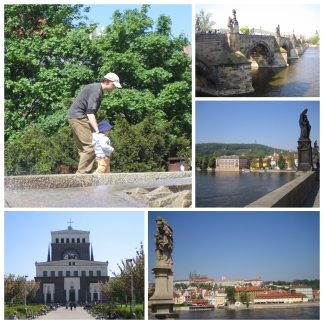















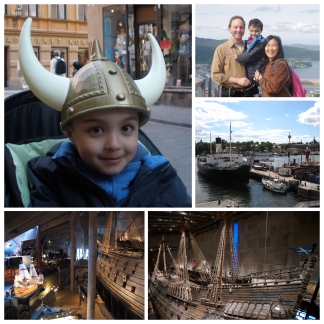














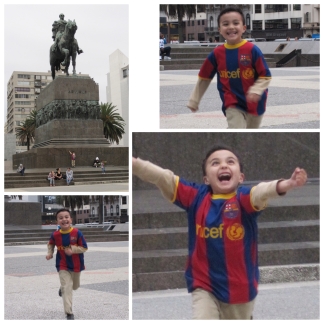

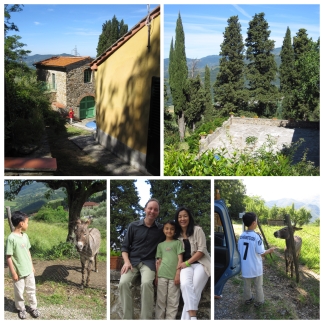




































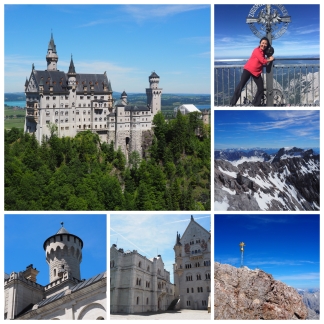










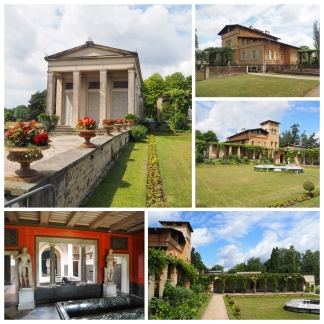






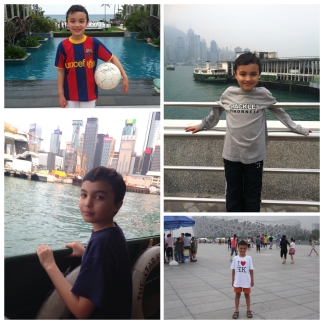





 Hong Kong has a special place in my heart. It is a city my family likes to visit again and again. My husband goes there often on business trips. My son loves to jump on and off the beautifully built, one-of-a-kind Star Ferry shuffling people from Hong Kong’s one island to another. To me, Hong Kong is like a giant collage juxtaposed between eastern and western cultures. It is a soft landing pad enabling me to travel back and forth without feeling lost in either world. There is also a deeper level of connection for me with Hong Kong. Each year we travel there on route to see my parents. They live one hour away — about 10 years ago my parents joined China’s elderly “snow birds” splitting their time between the north and south. Once we arrive in Hong Kong, I can feel their presence and the excitement of my coming home rises up.
Hong Kong has a special place in my heart. It is a city my family likes to visit again and again. My husband goes there often on business trips. My son loves to jump on and off the beautifully built, one-of-a-kind Star Ferry shuffling people from Hong Kong’s one island to another. To me, Hong Kong is like a giant collage juxtaposed between eastern and western cultures. It is a soft landing pad enabling me to travel back and forth without feeling lost in either world. There is also a deeper level of connection for me with Hong Kong. Each year we travel there on route to see my parents. They live one hour away — about 10 years ago my parents joined China’s elderly “snow birds” splitting their time between the north and south. Once we arrive in Hong Kong, I can feel their presence and the excitement of my coming home rises up.